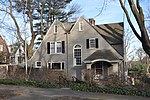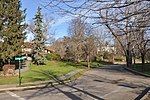Capt. Edward Durant House
Historic house museums in MassachusettsHouses on the National Register of Historic Places in Newton, MassachusettsMassachusetts museum stubsMuseums in Middlesex County, MassachusettsNewton, Massachusetts Registered Historic Place stubs

The Durant-Kenrick House and Grounds is a historic late First Period house at 286 Waverly Avenue in Newton Centre, Massachusetts, that is now a historic house museum.
Excerpt from the Wikipedia article Capt. Edward Durant House (License: CC BY-SA 3.0, Authors, Images).Capt. Edward Durant House
Waverley Avenue, Newton Newton Corner
Geographical coordinates (GPS) Address Nearby Places Show on map
Geographical coordinates (GPS)
| Latitude | Longitude |
|---|---|
| N 42.346111111111 ° | E -71.181111111111 ° |
Address
Waverley Avenue 286
02172 Newton, Newton Corner
Massachusetts, United States
Open on Google Maps











